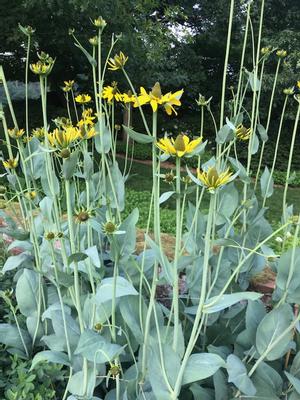Printed at http://www.newmoonnursery.com/index.cfm/
Rudbeckia maxima
Giant coneflower
Native to North America
FIRST IMPRESSIONS: Rudbeckia maxima is a super-sized black-eyed Susan with sturdy upright stems and a strong architectural presence. The bold attractive basal leaves average 2’ long with a lovely bluish waxy patina. Stalks rise from the foliage and are terminated in early summer by bright yellow daisies. Each daisy-like head consists of a beefy elongated dark brown cone and a ring of drooping rays. This unique species thrives in sunny sites with deep moist soils or in average garden conditions.
HABITAT & HARDINESS: Rudbeckia maxima is indigenous to moist sunny sites including prairies, meadows, pastures, roadside ditches and fields in Texas, Louisiana, Arkansas. Oklahoma and South Carolina.
This species is hardy from USDA Zones 5-9.
PLANT DESCRIPTION: Rudbeckia maxima is a bold clump forming perennial wildflower.
Plants form basal rosettes of attractive waxy blue-green foliage. The blades are similar to those of a cabbage or collard. Leaves average 18” long and are entire and oval with long slender petioles.
In late spring, flower stems rise from the foliage rosettes to 6’ or more. The stems are terminated in 2-3” daisy-like heads. The drooping ray florets are a lovely clear yellow. They surround a large elongated chocolate brown cone.
The dark brown seedheads persist often into the early winter.
Plants are 6-8’ tall and 3’ across. They spread from rhizomes to form colonies.
CULTURAL & MAINTENANCE NEEDS: Rudbeckia maxima prefers full to partly sunny sites with moist fertile soils.
This handsome coneflower is heat tolerant and not particular about soil type. Plants thrive in sandy, clay or organic soils. This species can even tolerate flooded soils for short times or drought after establishment.
Plants are pest resistant and foliage is unpalatable to deer and other herbivores.
This species spreads slowly by rhizomes. Flower stalks can be cut to the ground after blooming to tidy the garden and stimulate longer flowering. Ideally, however, the stalks should be left to provide seed for the goldfinches.
LANDSCAPE USES: Rudbeckia maxima is a dramatic Accent plant with Showy Blooms. Plants are appropriate in Groupings or Mass Plantings for Wildlife Gardens or moist Meadows. This is a useful Butterfly Nectar Plant or Cut Flower that is appropriate for Cottage Gardens, Deer Resistant Plantings, Low Maintenance Plantings, Perennial Borders, Rain Gardens, Stormwater Management Projects and edges of Water Gardens.
COMPANION & UNDERSTUDY PLANTS: Try pairing Rudbeckia maxima with Aster novae-angliae, Monarda fistulosa, Penstemon digitalis 'Husker Red', Carex amphibola, Carex radiata, Panicum virgatum or Sorghastrum nutans.
Silphium perfoliatum is a possible substitute as it has comparable height, similar cultural requirements and also bears yellow composite flowers.
TRIVIA: Flowers attract native bees and butterflies. Seed are eaten by goldfinches and other small birds.
Rudbeckia maxima was discovered by English botanist and plant explorer Thomas Nuttall (1786-1859) in 1816 near the Red River in Oklahoma Territory.
The foliage is quite striking because of the steely blue color and waxy sheen. This species is often called cabbage leaf coneflower because the unique leaves are shaped and colored like those of garden cabbage.
Plants can be quite tall – especially in moist fertile sites. Since the majority of leaves are basal, however, the 7’ mostly leafless flower stalks allow the viewer to “see through”.
Height:
6-8 ftSpread:
3-4 ftSpacing:
4 ftUSDA Hardiness Zone:
5-9Bloom Color:
YellowRudbeckia maxima Characteristics
Attracts Wildlife
- Songbirds
- Pollinators
- Butterflies
Attributes
- Dried Flower
- Cut Flower
- Rain Garden
- Clay Soil
- Naturalizing
- Drought Tolerant
Exposure
- Full Sun
Deer Resistant
- Deer Resistant
Flowering Months
- August
- July
Foliage Color
- Green
Growth Rate
- Medium
Juglans nigra Tolerance (Black Walnut)
- Yes
Season of Interest (Foliage)
- Summer
- Spring
Soil Moisture Preference
- Moist to Dry
Interesting Notes:
For more information on this plant, visit the USDA PLANTS Database: http://plants.usda.gov/java/profile?symbol=RUMA3

